Difference Between 8085 Microprocessor and 8086 Microprocessor
The main difference between 8085 and 8086 microprocessor is that 8085 is an 8-bit microprocessor while 8086 is a 16-bit microprocessor, which is an upgraded version of 8085 microprocessor developed by Intel Corporation.
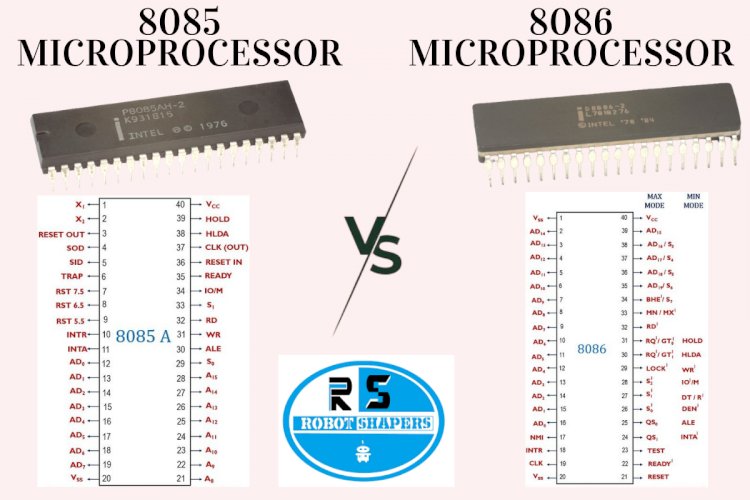
What is a Microprocessor?
A microprocessor is an electronic chip that functions as a central processing unit or the brain of a computer or micro-controller. It is made up of millions of transistor, diodes and resistors and it is responsible for any arithmetic or logical operation. The microprocessors do not have RAM or ROM inside it. But they do have registers to stores the outcome from the ALU (Arithmetic Logic Unit).
What is a 8085 Microprocessor?
The 8085 pronounced as “Eighty-Eighty-five” is a 8-bit microprocessor first introduced by Intel in the year 1976 where Eight denotes 8-bit and Eigthy-five refers to Intel Code. . А upgraded version of Intel 8008/8080 processors. In this processor, 2 new instructions were added to turn on / off the 3 terminals and the Input / output ports, and simplified the hardware using only a + 5V (Volt) current, as well as added a time impulse generator and circuit control circuit.
Its data bus is 8-bit long which means it can process 8-bit of data at a time. Its address bus is 16-bit wide which means it can access 216 different memory locations. Since each memory location contains a byte (8-bit) of data, the maximum accessible memory capacity of 8085 becomes 64KB. It is equipped with an on-chip internal oscillator of 3 MHz.
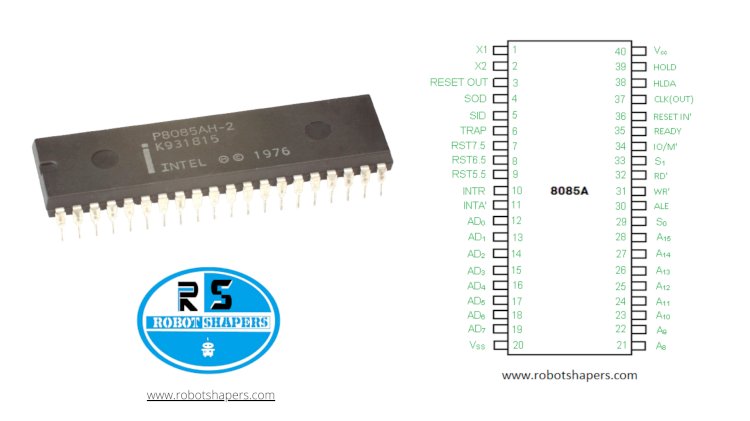
The 8085 is an accumulator based microprocessor which means the data being used for operation and the results of the ALU (Arithmetic Logic Unit) are stored in the accumulator. It also stores the intermediate results of the ALU.
The reason it has an 8-bit data bus is that it has an 8-bit ALU (Arithmetic Logic Unit). Its Arithmetic Logic Unit is capable of the operations such as, add, subtract, increase, decrease, compare, shift, complement, ADD, OR, X-OR. The 8085 performs sequential execution of the instruction in the following order : fetching, decoding and execution. It does not support pipelining.
Furthermore, this microprocessor requires +5V supply to operate at 3.2 MHz single phase clock. It uses a multiplexed address/data (AD0 – AD7) bus. In addition, the 8085 circuit requires an 8-bit address latch. Therefore, Intel manufactured a number of chips with an address latch built in. Moreover, it is in a 40 pin DIP package. It has 8-bit data bus, 16-bit address bus, 16-bit program counter, 16-bit stack pointer and six 8 bit registers arranged in pairs.
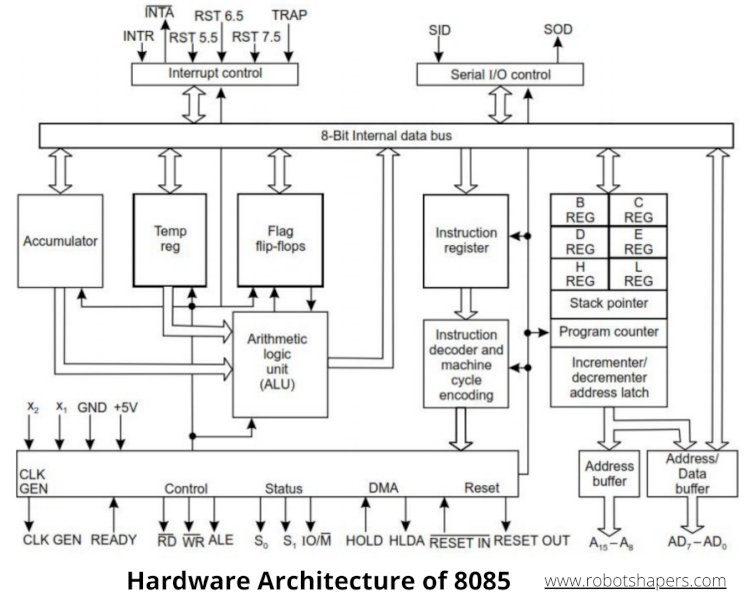
This microprocessor requires few hardware components, but their placement and functionality can provide very high work efficiency. The microprocessor 8085 is very similar to microcontrollers, such as PIC 16f84, which are widely used in process control. According to its power, 8085 cannot be compared to Pentium microprocessors, but it will be used for a long time because it has a great application in simpler electronic devices that do not require such powerful processors. This is an eight bit processor, which is processing data with a size of a byte. It has a clock speed generator with a digital clock speed of 8 MHz, a special controller for intermittent operation and timing control. It has access to memory with a capacity of 64K.
Technical specifications
- Frequency 5MHz;
- about 6500 transistors per 1 μm
- Data bus of 8 bit
- The AH version has a 20% lower power consumption than the normal 8085 processor.
- Direct memory addressing of 64 Kbps;
- 3 μs command line (0.8 μs at 8085AH-2 /0.67 at 8085AH-1);
- 4 vector interrupt inputs (one cannot be masked);
- decimal, binary and arithmetic with double precision.
- It Provides 16bit Address lines so it can access 216= 64K bytes of memory.
- It generates 8bit I/O address so it can access 28=256 input ports.
- It provides 5 hardware interrupts :TRAP,RST 5.5,RST 6.5,RST 7.5,INTR.
- It provides acc, one flag register ,6 general purpose registers and two special purpose registers(SP,PC).
- It provides serial lines SID, SOD.so serial peripherals can be interfaced with 8085 directly
What is 8086 Microprocessor?
8086 is a 16-bit microprocessor that is designed to perform execution over 16-bit data in one cycle by Intel in 1976. The architecture of this processor is x86 architecture. The reason behind it being a 16-bit microprocessor is the size of its ALU. It is the enhanced version of the 8085 microprocessor. It has a 16-bit data bus with a 16 bit ALU. The address bus is 20-bit long; therefore the accessible memory capacity of 8086 microprocessor is 220 Bytes or 1MB. Furthermore, this microprocessor has three versions. The operating frequency of regular 8086 is 5MHz; an operating frequency of 8086-2 is 8MHz whereas 8086-1 operating frequency is 10MHz.
The 16-bit ALU capable of performing all the operations of 8085’s ALU and also the operation of Multiplication and Division.
8086 has two separate operating units that work independently :-
- Bus Interface Unit (BIU) and
- Execution Unit (EU)
The Bus Interface Unit (BIU) is responsible for interfacing external components, fetching instruction and maintaining prefetch instruction queues also known as pipelining. It helps in increasing the execution speed of the instruction by fetching the next instruction while executing the current instructions.
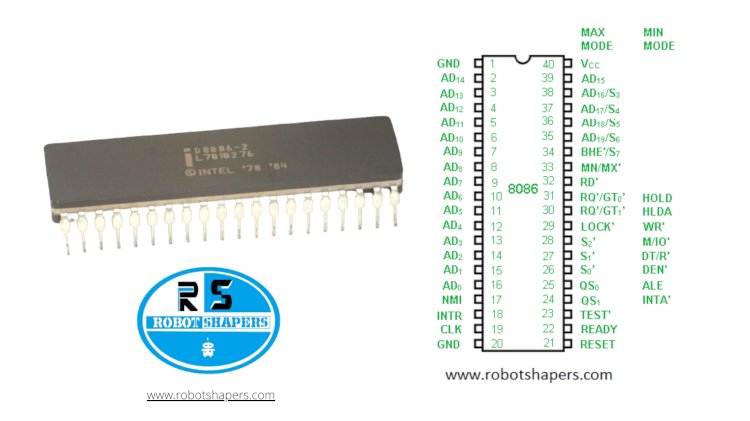
The EU contains ALU and registers that fetch the instruction from BIU, decode it and execute it. The presence of an instruction queue in 8086 acts as an advantageous factor when compared with the 8085 microprocessor.
This is so because, by the help of instruction queue, BIU can pre-fetch the instructions and can store them in 6-instruction bytes from memory. This somehow reduces the instruction execution time and correspondingly the overall efficiency of the system.
Moreover, this microprocessor operates in two modes. They are the minimum mode and maximum mode. The minimum mode is suitable for single processors whereas maximum mode is suitable for multiple processors that shares a common RAM.
It is a general-purpose register-based microprocessor. It uses registers to stores the data being used and the results and the intermediate results from the ALU. There are 14 internal registers each 16-bit wide.
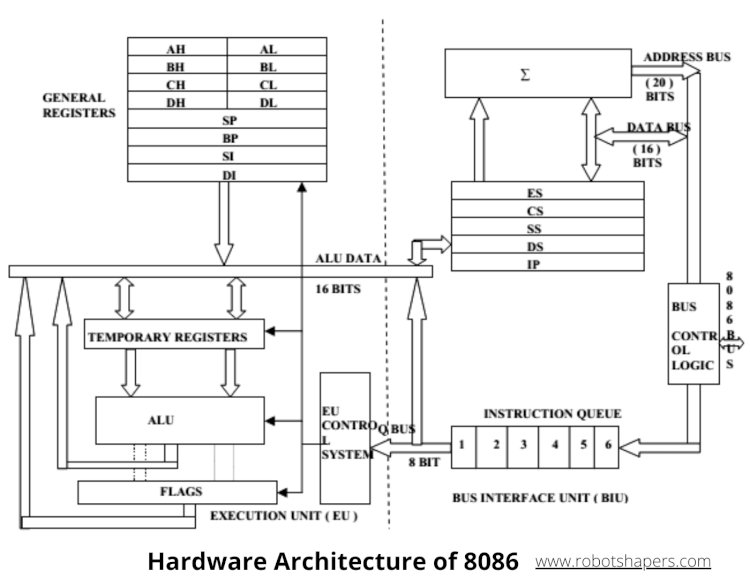
8086 are third-generation microprocessors. 8086 has a memory with a capacity of 1 MB (220) and 20 bit addresses are used to address the memory locations. 8086 has a 40-pin housing and uses a 5V power supply.
8086 contains separate units that simultaneously perform some phases (transfer of operating code from memory to microprocessor – opcode fetch, operand transmission if requested – read, effective execution – execution, return of the result to the memory – write). 8086 works exclusively in realistic mode of operation. Starting from 8086 to 80286, the following addresses are in use: registers addressing, immediate, direct, registering indirectly, based, indexed, based-indexed and based-indexed with displacement.
Technical Specifications
- Frequency up to 10 MHz;
- about 29000 transistors per 1 μm
- Data bus of 16 bit
- Direct memory addressing of 1 MB;
- Minimum and maximum mode
- Decimal, binary and ASCII.
- It has 16-bit data bus
- It can be read or write data to memory /port either 16 bits or 8 bit at atime
- It has 20-bit address bus which means, it can address up to 220= 1Mb memory location
- 8086 has a 16-bit flags register
- The 8086/8088 could be connected to a mathematical co-processor to add hardware/microcode-based floating point performance
- The Intel 8087 was the standard math co-processor for the 8086 and 8088, operating on 80-bit numbers
Here's the basic Difference Between 8085 Microprocessor and 8086 Microprocessor :-
|
Basis Of Distinction |
8085 Microprocessor |
8086 Microprocessor |
|
Microprocessor Type |
It is a 8-bit microprocessor introduced by Intel. Released in 1976. |
It is a 16-bit microprocessor introduced by Intel. Released in 1979. |
|
Data Bus Size |
Its has 8-bit wide Data bus. |
It has 16-bit wide Data Bus. |
|
Address Bus size |
It has 16-bit wide Address Bus. |
It has 20-bit wide Address Bus. |
|
ALU (Arithmetic Logic Unit) |
It has an 8-bit ALU. |
It has a 16-bit ALU. |
|
Supportable Memory Size |
64KB |
1MB |
|
Clock Speed |
3.071 MHz |
5MHz - 8086 8MHz - 8086-2 10MHz - 8086-1 |
|
Clock cycle |
Operated on Clock cycle with 50% duty cycle. |
Operates on Clock cycle with 33% duty cycle. |
|
Data processed in one cycle |
It can process an 8-bit of data in one machine cycle. |
It can process 16-bit of data in one machine cycle. |
|
Number of Flag Register |
5 Flags (Sign Flag, Zero Flag, Auxiliary Carry Flag, Parity Flag, Carry Flag). |
9 Flags (Overflow Flag, Direction Flag, Interrupt Flag, Trap Flag, Sign Flag, Zero Flag, Auxiliary Carry Flag, Parity Flag, Carry Flag). |
|
Pipelining |
It doesn’t support pipelined architecture. |
It support pipelined architecture. |
|
Number of Transistors |
Around 6500 |
Around 29000 |
|
Memory Segmentation |
Unsupportable |
Supportable |
|
Modes of operation |
No separate mode |
Minimum (Single Processor mode) and Maximum (Multiprocessor mode) |
|
Arithmetic |
Decimal, integer |
Decimal, integer and ASCII |
|
Processor number |
Only one processor is used |
More than one processor is used. External processor can be used |
|
Instruction Queue |
Absent |
It has an instruction queue of 6-bytes that is stored in FIFO (First In First Out) register. |
|
Addressing Mode |
5 |
9 |
|
Type of processor |
It is accumulator based processor. |
It is general purpose register based processor. |
|
Instruction |
No multiplication and division instruction. |
Multiplication and Division operations are present. |
|
Operations performed |
Perform operations upto 28 i.e 256 numbers. A number greater than this is taken multiple times in 8-bit data bus. |
Can perform Operations upto 216 i.e 65,536 numbers. |
|
Cost |
Cheap |
Expensive |

 Arindam Deshmukh
Arindam Deshmukh 



















